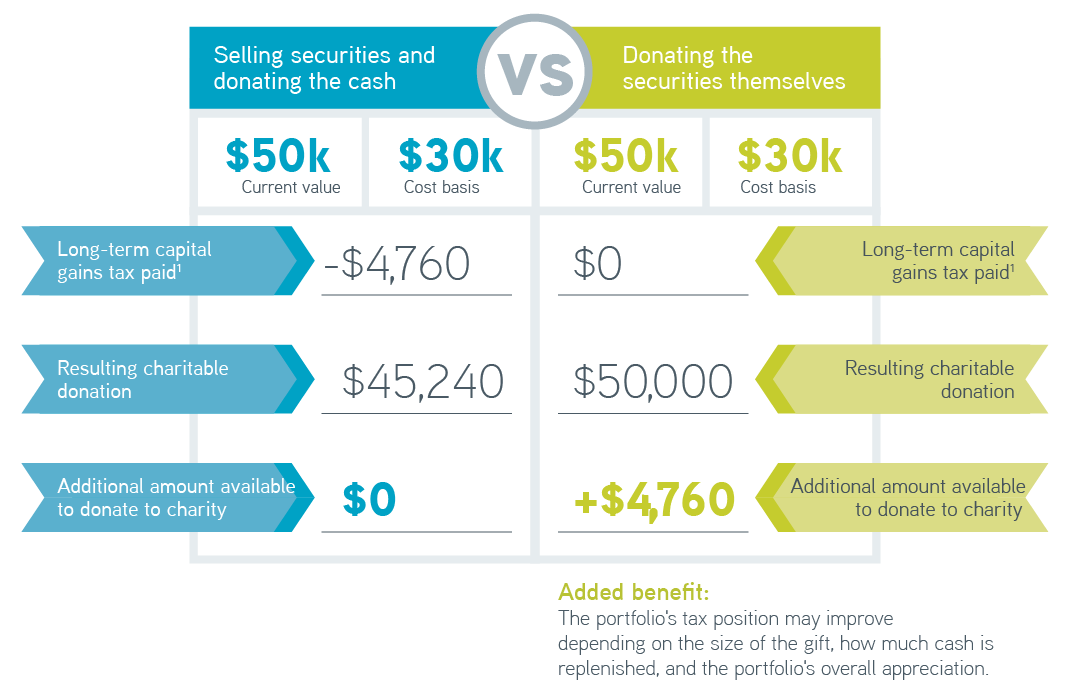
Challenge
A client makes an annual cash gift to her local food bank, funding her contribution by selling stock in her investment portfolio. While she appreciates the tax deduction for charitable giving, she’s also paying taxes on capital gains incurred from selling the appreciated stock. She asks Parametric if there’s a more tax-efficient way for her to make charitable donations in coordination with the tax management Parametric already performs on her Custom Core® account.
Parametric solution
Making charitable gifts in cash is a natural instinct for many people. After all, cash gifts may lessen an investor’s current tax bill by reducing taxable income by the amount of the gift (subject to limitations, of course). But cash gifts aren’t the only option. For example, when you donate stock to a charity, you get the added benefit of receiving a tax deduction for the full fair-market value. As the below example demonstrates, this approach also represents an increase of more than 10% in the size of the gift as opposed to selling the shares and then donating the cash, since you avoid the payment of capital gains tax incurred when selling the shares.
In the case of this client, Parametric suggested a two-step course of action. First, we identified suitably appreciated securities from the client’s Custom Core portfolio, recommending a list of low-basis securities that, when donated, would maximize the capital gains transferred through the gifting process. Second, the client deposited cash equal to the value of stocks gifted. Parametric then used this cash to purchase stocks that allow the portfolio to maintain the client’s chosen market exposure but that have a much higher cost basis than the gifted shares. This higher-basis investment increases the potential for tax-loss harvesting, which should help reduce future tax payments.

Source: Source: Parametric, 2020. Provided for educational purposes. No representation is made that a client will, or is likely to, achieve results similar to those presented.
1 Assumes all realized gains are subject to the maximum federal long-term capital gains tax rate of 20% plus the 3.8% Medicare surtax, for a total rate of 23.8%. Does not take into account state and local sales tax, if any apply.
Results
By gifting appreciated securities from her Custom Core portfolio, the client was able to donate a higher dollar amount to her favorite charity, potentially increasing her charitable tax deduction in the process. By then investing an equivalent amount of cash back into her Custom Core portfolio, she was able to purchase a number of securities with higher basis, resulting in a portfolio with a higher potential for tax-loss harvesting and reduced tracking error.
At Parametric, we manage more than $134 billion in assets in Custom Core accounts alone, with $145.5 billion in client-specified tax mandates.* Charitable gifting—and how to optimize its impact—is a critical component of our comprehensive approach to tax management.
*As of 12/31/2020.
This material is provided for illustrative purposes only and should not be construed as investment advice, a recommendation to buy or sell specific securities, or direction to adopt any particular investment strategy. This material is based on the experiences and observations of Parametric. No representation is made that a client will, or is likely to, achieve results similar to those presented. Actual results will differ and may differ substantially from the example provided. Client outcomes will differ depending on each client’s specific circumstances as well as changes in securities or financial markets or general economic conditions. All investments are subject to risks, including the risk of loss.


